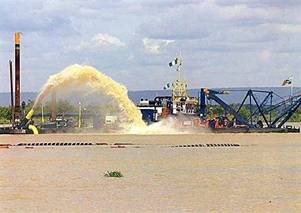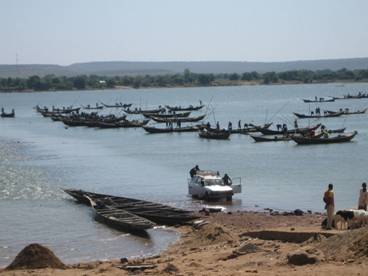
Jamata Bridge is the dividing line between Lot 3 and Lot 5 in the ongoing dredging of the River Niger. Lot 3 was awarded to Van Oord while Lot 5 was awarded to William Lloyds Technical Company. While the consultants to the project say that Lot 3 has been executed and is in finishing stages, Lot 5 has not been done and is now the subject of some controversy about quantities. To this end, there are problems starting from Jamata bridge.
The first phase of the huge dredging project costing Nigerian tax payers N32 billion faces two major problems on its way to becoming a success. Firstly, the National Inland Waterways Authority (NIWA), which is in charge of Nigerian inland waterway transportation and for whom the project was supposed to be a boost, is now worried at the seeming lack of patronage of a waterway it claims has been dredged! But has it really been dredged to specification? If so, why the altercation about Lot 5, Lokoja to Baro, a stretch of 75 kilometres? Or, is this segment of the project not in the contract? If Lot 5 has not been done, what is the moral justification of going to the media with claims about a project that has been completed? Again, assuming River Niger has been dredged and the public knows this, why the fret by NIWA about low patronage of the waterways? Is the reason not the very poor handling of the information dissemination about the project and the virtual lack of openness in the procedures of the project? Can NIWA demonstrate that any good transparency has been attached to the execution or the monitoring of the project by releasing specifications and data about all aspects of a project that is supposed to be wholly in the public domain but has been managed so far as a private estate of NIWA top officials, federal ministry of transport desk officers and the contractors?
Ordinarily, dredging the River Niger was supposed to open it to all-year navigation and thus attract barges, ferries and ships bearing cargoes up to Baro in Niger state from Warri in Delta state. By this calculation, companies like Ajaokuta steel plant, cement companies at Benue state, long-distance haulage firms, oil and gas firms shipping fuel to the north, to name a few, ought to be attracted to haulage via the river Niger. But can any pilot or ship master set sail on inland waters that are as yet uncharted? Information available to DDH says that the best many of the contractors have done so far is to import the buoys. Few have been laid. This means that the rivers have not been charted for depths, wrecks, etc. How can this translate to completion of River Niger’s dredging for the purpose of all-year navigability? These questions create credibility problems for the overall project.
From the look of things, therefore, not much navigation by big vessels is happening along the River Niger as yet and there are very few indications that things will pick up soon, prompting a stakeholders conference which was hastily put together some weeks ago at Lokoja by NIWA. Eye witness accounts say the venue was cramped with people who came with questions and concerns about the entire dredging project and the way it was being handled. Prominent in this category were indigenes of Baro, a community which was looking forward to the day the dredging project would open up access again to the port they used to know in the colonial era as a bee-hive of activity. Despite months of huff and puff about the dredging taking place, the Baro community was yet to see their part of the river dredged for the promised new dispensation; no ships have visited of late and no barge carrying goods have crossed their shores or anchored at their old wharf. So, they were at the Lokoja conference, but few answers were forthcoming from the NIWA management. But what is the problem?

This brings us to the second aspect of the river Niger dredging handicap: the contractors. Earlier in the year, the transport minister, Alhaji Yusuf Suleiman had scolded some of the contractors for shoddiness or poor delivery of the jobs on their lots. Van Oord and William Lloyds Technical Company Ltd were fingered in this connection. Lot 5, Lokoja to Baro, was awarded to William Lloyds Technical Company but as at press time, not much progress has been made because of a dispute about quantity of spoil to be removed during the channel dredging aspect of the contract. Nine hundred thousand cubic metres was the original quantity in the contract earmarked for lot 5. A reliable source from one of the major consultants said William Lloyds disagreed with this quantity and insisted that 7.6 million cubic metres is the actual figure they found on ground to be scooped from the river bed. This figure which translates to billions of Naira drew a sharp disagreement from many quarters including the federal ministry of transport and the major consultant, Royal Haskoning. Suleiman has expressed unhappiness that the consultants could have come up with this figure when the contractor had scooped up one million cubic metres, and with 90% of the job yet to be done! Sources close to the matter however reveal that the time differential between the original survey date and the time of contract award could explain some of the disparity in question, coupled with releases of water from the Kainji dam which could have released much sand into the river bed. But these factors were thought not to be enough to warrant as high a figure as over 7m cubic metres being quoted by the contractor. So, no progress could be made while this dispute lasted and this explains why the Baro community could see no action on their end of the river.
What is being done now?
After all the bickering, a combined team of surveyors from William Lloyds, NIWA, federal ministry of transport and Royal Haskoning has been constituted to refresh the survey of the lot and after this exercise, there is hope of an agreement on the quantity of spoil and then the channel dredging would commence. It is still expected that the channel dredging would be completed in November 2010 after which the maintenance dredging aspect of the job would begin, lasting the next two years. As at press time, laying of buoys is said to have finished at Lot 2 and set to begin at all the other Lots aside from the problematic Lot 5. Confirming this development to DDH, our reliable source said most of the buoys have been received by the contractors from overseas while a few were still at the ports being cleared from customs. But he was upbeat that progress on laying of buoys was progressing according to schedule.
But that still leaves the federal government at a quandary about the crisis of confidence now besetting the entire project: would the maritime industry repose enough trust in this job as to set sail on the waterway with their ships, barges, tug boats and other heavy-duty watercrafts? Only time and the eventual handling of the information dissemination process about the dredging project would be the decider.
